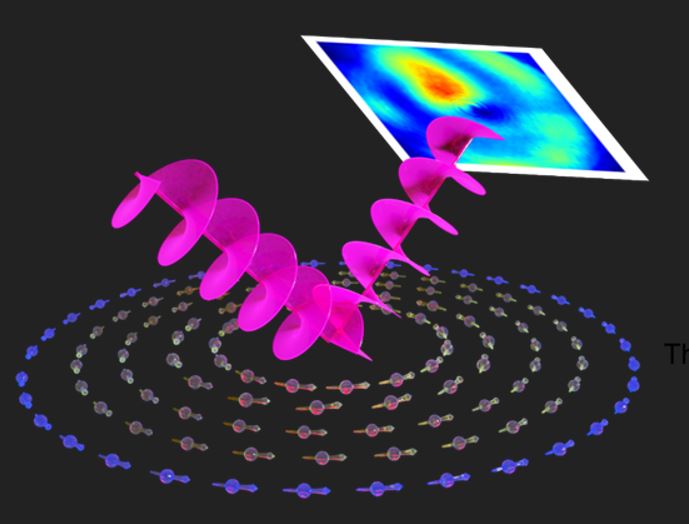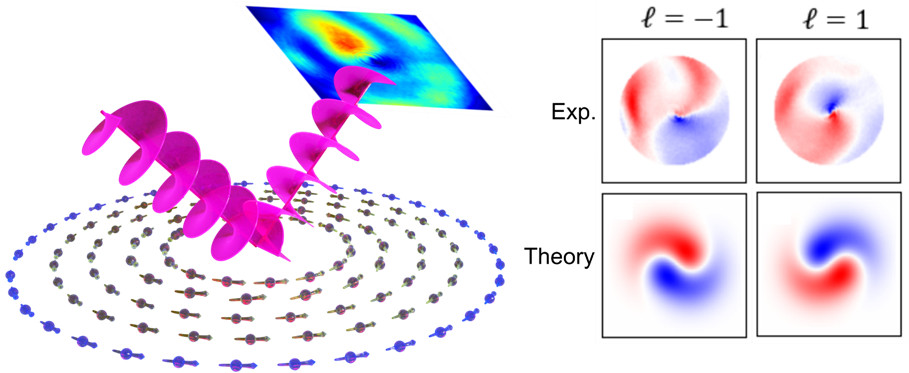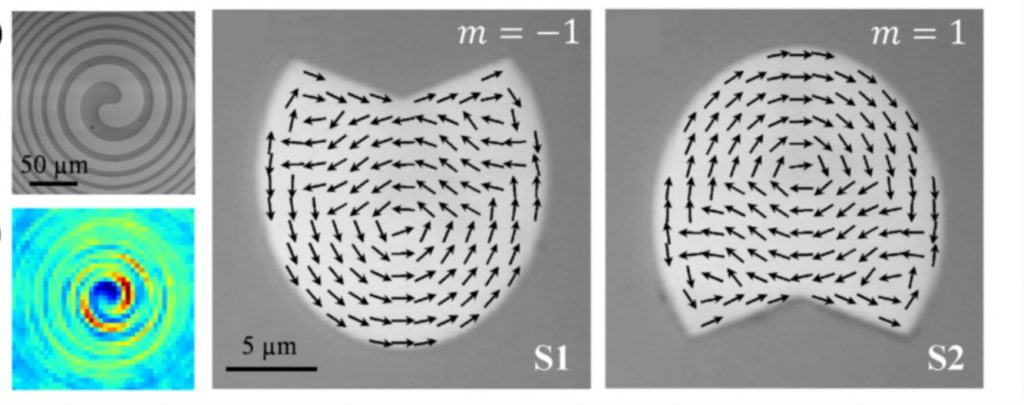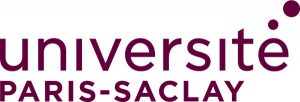Magnetic nanostructures are essential for data storage (MRAM, high-density hard disks) and in magnetic sensors and actuators. To probe the local magnetism, magnetic circular dichroism (MCD) and the magnetic Kerr effect (MOKE) both rely on the differential absorption of light according to the direction of its circular polarization (associated with photons of opposite spin orientation). However, a detailed understanding of their dynamics on the femtosecond scale remains to be explored.
Light can also carry a second type of angular momentum, known as “orbital”, associated with electromagnetic waves with helical wavefronts. Magnetic helical dichroism (differential reflection of light carrying opposite orbital angular momentum) has been shown to exist, and offers multiple advantages. In particular, it could become the method of choice for time-resolved studies of magnetic structures such as skyrmions or magnetic vortices, whose characteristic size (~1 µm) corresponds to that of the helical wavefront.

Magneto-optics is the tool of choice for studying magnetism, with a wide range of observation wavelengths (from teraHz to XUV) and femtosecond-scale dynamic measurements. All these measurements rely on the coupling between the circular polarization (or spin angular momentum – SAM) of light and magnetism. However, light can also carry another type of angular momentum, the orbital angular momentum (OAM). Beams carrying such an OAM exhibit a helical wavefront, where the number of interlocking helices determines the integer value ℓ of the OAM, and their direction of rotation determines its sign. As circularly polarized light can be either left- or right-handed, light carrying an OAM can take two mirror-image forms.
Magnetic helical dichroism, which results from the differential interaction of beams carrying left and right OAM with magnetic surfaces, was only recently revealed in 2019 [1]. The effect relies on the presence of a magnetic field at the center of the OAM carrier beam, which interacts with the magnetic moment carried by the probed structure. In the same year, Fanciulli and colleagues predicted another direct OAM-dependent effect, to appear in reflection on magnetic vortex structures (see figure). [2].

Observation of magnetic helical dichroism on a magnetic vortex. Left: an ultraviolet beam carrying an orbital angular momentum ℓ is reflected by a magnetic vortex and forms a far-field image. Right, top: difference between images acquired for two opposite directions of rotation of the magnetic vortex. This dichroism shows a 2D chiral structure in agreement with theory (bottom) and whose direction is a function of the sign of the orbital angular momentum (OAM) of the probe light (top).
A collaboration involving scientists from eight institutions has just demonstrated this effect. The permalloy magnetic sample exhibits a vortex-like magnetization whose direction of rotation is determined by the direction of the magnetic field during the initial magnetization of the layer. It is placed at the focal point of the DIPROI experimental device, receiving the beam from the FERMI (Elettra) XUV free-electron laser in Trieste, Italy. The laser pulse duration is of the order of a few tens of femtoseconds, and the reflected beam forms a far-field image featuring chiral asymmetry, a signature of the presence of polarized vortices. The direction of the image (right or left) depends on the direction of the vortexes and that of the OAM (see figure). A classical theory, based on the use of magneto-optical reflection coefficients, allows to reproduce these results.

Top left: spiral Fresnel plate, used to impart orbital angular momentum to the FERMI free-electron laser beam (Elettra-Sincrotrone Trieste S.C.p.A.). Below: interference of the OAM beam with a reference beam (without OAM). The spiral pattern is a signature of the beam’s OAM.
Center and right: remanent magnetization of S1 or S2 magnetic vortices, whose direction of rotation depends on the orientation of the initial external saturating magnetic field pulse applied.
This observation opens up a new avenue for magneto-optical characterization of magnetic nanostructures, but also raises a number of questions:
- What is the origin of the coupling between the OAM of light and macroscopic magnetization? Can it induce magnetic transitions?
- Is imaging without scanning or polarization inversion feasible?
- Can magnetization dynamics be explored using this technique? With which time resolution?
that the LIDYL laboratory is seeking to answer with the ATTOLab platform. To this end, a specific device is currently being built with the support of the ANR (HELIMAG Project) and Labex PALM (AttoFoam Project), which will benefit from the teams’ experience in synthesizing ultrafast beams carrying an OAM in the XUV range [4-5].
References:
[1] “Terahertz vortex beam as a spectroscopic probe of magnetic excitations”,
A. Sirenko, P. Marsik, C. Bernhard, T. Stanislavchuk, V. Kiryukhin, and S.-W. Cheong, Physical Review Letters, 122 (2019) 237401.
[2] “Electromagnetic theory of helicoidal dichroism in reflection from magnetic structures”,
M. Fanciulli, D. Bresteau, M. Vimal, M. Luttmann, M. Sacchi, and T. Ruchon, Physical Review A, 103 (1) (2021) 013501.
[3] “Observation of magnetic helicoidal dichroism with extreme ultraviolet light vortices”,
M. Fanciulli, M. Pancaldi, E. Pedersoli, M. Vimal, D. Bresteau, M. Luttmann, D. De Angelis, P. R. Ribič, B. Rösner, C. David, C. Spezzani, M. Manfredda, R. Sousa, I.-L. Prejbeanu, L. Vila, B. Dieny, G. De Ninno, F. Capotondi, M. Sacchi, and T. Ruchon, Physical Review Letters, 128 (2022) 077401.
[4] “Synthesis and characterization of attosecond light vortices in the extreme ultraviolet”,
R. Géneaux, A. Camper, T. Auguste, O. Gobert, J. Caillat, R. Taïeb & T. Ruchon, Nature Communications, 7 (2016) 12583.
[5] “Tunable orbital angular momentum in high-harmonic generation”,
D. Gauthier, P.R. Ribič, G. Adhikary, A. Camper, C. Chappuis, R. Cucini, L.F. DiMauro, G. Dovillaire, F. Frassetto, R Géneaux, P. Miotti, L. Poletto, B. Ressel, C. Spezzani, M. Stupar, T. Ruchon and G.D. Ninno, Nature Communications 8 (2017) 14971.
Contact CEA-IRAMIS: Thierry Ruchon, Groupe Attophysique, CEA-LIDYL
Collaboration:
- LIDYL CEA- Iramis, Saclay
- Spintec, CEA-IRIG, Grenoble
- Laboratoire de Physique des Matériaux et Surfaces, CY Cergy Paris Université,
- FERMI Elettra-Sincrotrone,
- Paul Scherrer Institut,
- Laboratory of Quantum Optics, University of Nova Gorica,
- Institut des NanoSciences de Paris – INSP, Sorbonne Université,
- Synchrotron SOLEIL
ANR HELIMAG project (2022-2027) : Lidyl – Spintec – Synchrotron Soleil – INP – IOGS.
Labex PALM AttoFoam project: “Attosecond focused beams carrying orbital angular momentum”.



